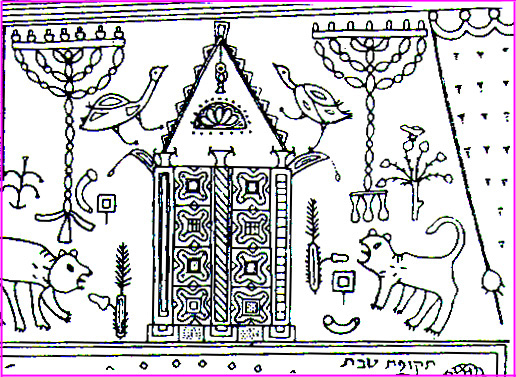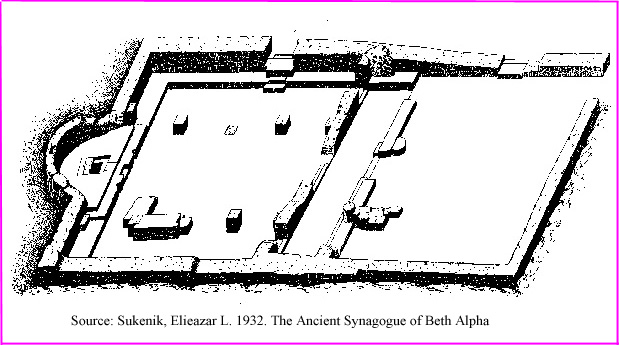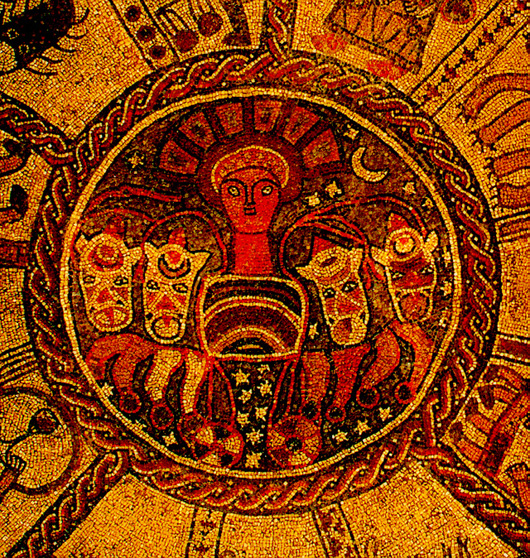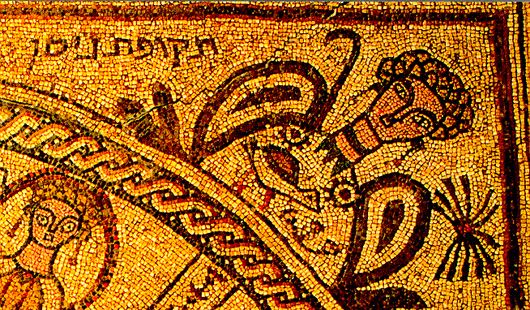
The So-called Ancient Synagogue at Beth Alpha Revisited
September 1998
In this article I endeavor to show that the categorization of the remains of an ancient building at Beth Alpha as a Jewish synagogue is a scientific fallacy. Archaeologists concluded that since the mosaics on the floor carry Jewish symbols, the structure must have been a Jewish synagogue. However, the remains also carry non-Jewish elements and in order to fit the building into their theory, archaeologists had to invent implausible explanations. I maintain that the same remains can lead to different conclusions.
It seems that even before the archaeologists visited the place, there had already been a presumption that the site occupied an ancient Jewish settlement. Sukenik, the archaeologist who first excavated the site, wrote (1932: 5):
At the end of December 1928, the members of the Beth Alpha settlement (situated on "Jewish National Fund" land) announced that in the course of digging a channel for conveying water to their fields from er-Rihaniya spring they had come upon remnants of a building paved with mosaic... The workmen at once stopped their digging, and one of their number was sent to Jerusalem to announce the discovery to the Zionist Executive, the Government Department of Antiquity and the Hebrew University, and to ask what to do with their discovery and how to continue their irrigation channel. From their description it at once seemed likely that a synagogue had been discovered in a locality formerly occupied by an ancient Jewish settlement.
The discovery has had also political implications. Sukenik (p. 6) related this episode:
On one of these rainy days Dr. J. L. Magnes, Chancellor of the Hebrew University, Jerusalem, accompanied by Dr. John Haynes Holmes of New York, reached us on horseback. We had just begun to clear the section of the pavement in which was depicted the Sacrifice of Isaac. Our guests were much interested in these remnants of the Jewish past now being laid bare, and also in the picture of the new life now coming into existence in this furthermost point of the modern Jewish settlement in the Valley of Jezreel.
However, as it was realized already at that time, the building seemed to include elements which were not compatible with what one would expect to find in a Jewish synagogue. Nevertheless, since it was determined that the building was indeed an ancient synagogue, explanations had had to be invented and theories to be amended so they fit the classification of the building. In this article I examine some of the explanations suggested during the years and present other possible explanations.
In one panel of the mosaic there are four-sided objects, decorated with round or square holes and having a projecting rod.

Sukenik (p. 28) wrote that Orfali explained such an object as a spice-box but he [Sukenik] found this explanation unacceptable, since a spice-box held no place whatever among the ritual objects of the synagogue.
However, there is also a possibility that the building at Beth Alpha was not a Jewish synagogue but something else and the objects were indeed spice-boxes.
The excavators found in the center of the platform a small cavity about 80 cm. deep, one meter long and 80 cm. wide and rounded on the south side. The cavity was walled in and its sides plastered. It was covered above with flagstones, one of which was still in place. Among the rubbish they found thirty-six Byzantine bronze coins which led the archaeologist to assume that the cavity served as the treasury of the synagogue (Sukenik 1932: 13).

I find it hard to accept this conclusion. Why did they need such a big treasury? Why would they place the money in the center of the synagogue and, moreover, in a place known to every local thief? If it was covered with heavy stones, how did they take money from it every day? Since it was too small for an adult to get in, the gabbai would have needed to go inside with his head first while one person would hold his feet and another holding a lamp so he could search for the right coins.
Avi-Yona (Encyclopaedia Judaica s.v. Synagogue) suggested that the depression in the apse served as a geniza (a place for storing worn-out or damaged sacred texts). That does not explain why the cavity was placed under the aron ha'qodesh (the Ark of the Law) and where did the coins come from.
I suggest that the cavity was used as a basin for ritual purification or baptizing. According to Sukenik (1932: 48) the earliest coin found in the cavity at Beth Alpha was from the time of Constantine the Great (306-337). From history books we know that Constantine was the first Christian emperor of the Roman Empire. During that time the building might have been turned into a church and the cavity was used for baptizing the infidels. The coins, I suggest, were thrown into the water for good luck and nobody had ever bothered to collect them. Writing on coins found buried underneath the stone floor at the ancient synagogue of Meroth, Zvi Ilan (1989: 27) suggested that "they might have been placed there to bring the building and its congregants blessing and good fortune, a tradition which persists in similar forms (tossing coins into fountains) to this day."
In the center of the Zodiac there is the sun in a form of a youth riding a chariot drawn by four horses. I suggest that the existence of the sun in the center is an indication that this is a solar calendar.

Sukenik (1932: 35) suggested that the mosaic depicted the sun rising out of the darkness of night and the motif was based on the traditional picture of Helios in Greek art. Why would Jews decorate their synagogue with Greek gods? Did not Jews rebel against foreign oppressors who had tried to force them to worship exactly these gods? What reason would Jews have to start respecting Greek gods at that time of history when paganism was disappearing?
The Zodiac at Beth Alpha is not compatible with the Jewish Zodiac. Sukenik wrote (1932: 38):
In the four corners of the square enclosing the cycle of the Zodiac are shown the four seasons of the year. It is hard to understand the reason why the craftsmen did not show the seasons near their corresponding months. Spring is found near the summer months, Summer near the autumn months, and so on. We find the same in the Na'aran mosaic. There the symbol of Spring is shown near the Zodiac signs Libra and Virgo, and Autumn opposite Aries and Pisces, and so on.
This Zodiac indeed differs from the Jewish Zodiac but I find it hard to believe that the artist who made the mosaic at Beth Alpha synagogue could have made such a gross mistake without anybody in the congregation noticing it. I would imagine that he was given instructions as of what to do and at least some members of the community were following his work. A project of such magnitude takes at least some months to accomplish and this gives plenty of opportunities for everybody to notice mistakes. In short, the Zodiac was intentionally constructed in this manner.
I suggest that the Zodiac at Beth Alpha was designed after 1 Enoch 82. Józef T. Milik (1976: 295), following his discovery of fragments of 1 Enoch in Aramaic in Cave 4 in Qumran, translated verse 82:9 in this way:
[...with regard] to their Zodiacal period, their new moons, their (daily) signs.
The author of 2 (the Slavonic Apocalypse of) Enoch, who was apparently influenced by 1 Enoch, wrote (30:5-6):
And I appointed the sun over the illumination of the days, but the moon and stars over the illumination of the night. And the sun goes in accordance with each animal, and the twelve animals are the successions of the months. And I assigned their names and the animals of their seasons, and their connection with the new-born, and their horoscopes, and how they resolve. (trans. F.I. Andersen)
Here is why I think that the Zodiac at Beth Alpha may have followed the Jubilees calendar:
a) In the center of the Zodiac at Beth Alpha the "sun" is riding on a chariot. The Jubilees calendar is a solar one. In 1 Enoch 72:4-5 we read:
First there goes out the great light whose name is the sun... The chariot on which it ascend is (driven by) the blowing wind.
The description fits well with 2 Enoch 15: 3:
...the sun (turn his chariot around) and goes back under the earth on wheels...
b) In verse 15 the name of the first month is Tam'ayen. In the zodiac of the Beth Alpha synagogue the sign of teomin (Gemini) is at the end of the winter and the beginning of the spring, the same period of the year when the Jubilees calendar starts.
c) In 1 Enoch 82, 14 we read:
The names of those who lead them are 'Adnr'ul, 'Iyasus- 'el, 'Elum'el - these three follow the leaders of the orders, as well as the four which follow after the three leaders of the order, which follow after those leaders of the stations that divide the four seasons of the year.
I suggest that the "three leaders of the orders" are turtledove, swift, and crane (tor, sis, agur) following Jeremiah 8: 7:
Even the stork in the sky knows her seasons And the turtledove, swift and crane keep the time of their coming;
Another example:
The blossom has appeared in the land The time of pruning has come The song of the turtledove is heard in our land. (The Song of Songs 2:12)
In the Zodiac of Beth Alpha there are two birds: one under the figure head of tekufat Nisan (spring)

and another one left of the head in tekufat tevet (fall). The turtledove indeed appears in the Land of Israel in the spring and the swift in the fall.
There are three birds in the panel of the Ark of Covenant, which may well represent agurim. Sukenik (1932: 22) wrote that they were apparently ostriches. According to Even Shoshan Hebrew Dictionary, agur is also a name of a group of stars called Grus, which appears in the south (seen from the Land of Israel) in the fall.
If indeed the signs of the Beth Alpha synagogue follow the Zodiac of 1 Enoch, the author of this book seemed to deviate from the Jewish signs. I suggest that he employed the Jewish signs but moved the circle counter-clockwise few months so it would fit what he calculated or thought to be the positions of the stars in the sky when God created the world. It is well known that the position of the stars in the sky is constantly changing.
By the time the building was constructed, there is no evidence that the Jews were still reading and preserving 1 Enoch or the Book of Jubilees. However, Christians did, which means that it is possible that someone else other than Jews had used this building.
Sukenik (1932: 9) maintained that there was no historic or literary memory, which bound up the site of Beth Alpha with the early days of the Hebrew people. I raise the possibility that the place was indeed a non-Jewish one and therefore it carried no historic or literary memory connected with Jews.
Two inscriptions were found at the entrance to the hall: one, in Aramaic, states that the mosaic was made during the time "of the king Justin "; the other, in Greek, gives the names of the mosaicists. According to Sukenik (1932: 44) the work was done by a craftsman who was apparently ignorant of Hebrew script or was not skilful in fashioning it. Why would Jews let a craftsman apparently ignorant of Hebrew script decorate their synagogues?
As for the King Justin, he might have been someone else than Emperor Justin I (518-527) usually assumed to be the person involved. But since the name of the mosacists is in Greek, why would the name of the emperor be written in (faulty) Aramaic? Since malka is also a synonym for God, I suggest as an improbable candidate for the mysterious 'Justin' a certain St. Justin Martyr, who was born c.100 C.E. in Neapolis (Shechem) and condemned to death by the Romans around 140 C.E.
Sukenik (1932: 11) wrote:
Like most of the synagogues north of Jerusalem and west of the Jordan, the building is oriented in an approximately southerly direction. A divergence to the west from this general direction (27 degrees S.W. by compass), which is actually justified in that Jerusalem is S.W. of Beth Alpha, is most probably accidental and due perhaps to the lie of the terrain.
It seems that too many 'mistakes' are connected with the site. Being curious to know where 27 degrees S.W. (minus 2 degrees due to compass deviation) leads, I used a protractor and a tourist map of Israel to discover that the line runs directly to Mt. Gerizim. I am very sorry but the Beth Alpha building was not at all a Jewish synagogue. (For more discussion on this matter see my article Ancient Synagogue in the Holy Land - What Synagogues? 1995)
All in all, the burden of providing plausible explanations as for why the remains at Beth Alpha are those of an ancient Jewish synagogue is still on the shoulders of the archaeologists.
References
Andersen, F.I. 1983. (trans.) 2 (Salvonic Apocalypse of) Enoch. In Charlesworth, James H. (ed).
Charlesworth, James H. (ed). 1983. The Old Testament Pseudepigrapha. London: Darton, Longman & Todd.
Hachlili, Rachel (ed.) 1989. Ancient Synagogues in Israel. B.A.R International Series (499).
Ilan, Zvi. 1989. The Synagogue and Beth Midrash of Meroth. In Hachlili, R. (ed.)
Isaac, E. 1983 (trans). 1 (Ethiopic Apocalypse of) Enoch. In Charlesworth, James H.
Milik, Józef T. 1976. The Book of Enoch. Oxford: Claredon Press.
Sukenik, Eleazar L. 1932. The Ancient Synagogue of Beth Alpha. London: Oxford University Press.
Up-to-date, Februar 12, 2006
In an article about an excavation in Megido where an ancient church was found, Amiram Barkat (Haaretz, November 7, 2005,
Prison dig reveals church that may be the oldest in the world
) writes that "The structure discovered at the Megiddo prison is a simple
rectangular
one lacking the later characteristics of churches, such as an apse facing east."
My (David Landau's) guess is that the building faced Mount Gerizim or directed towards another building that faced that mountain. If indeed this is the case, this ancient church belongs to the same grid as the structure at Beth Alpha.
Stephen Pfann, a biblical scholar and professor at the Holy Land University, said:
"This was a time of persecution and in this way it is quite surprising that there would be such a blatant expression of Christ in a
mosaic, but it may be the very reason why the church was destroyed." By Ramit Plushnick-Masti
Associated Press,
posted 07 November 2005: Israeli Prisoner Discovers Ancient Church
Up-to-date, November 21, 2006
With the publication of: Y. Tepper and L. Di Segni. 2006. Early Christian Prayer Hall from the 3rd Century C.E.. 59 pages,
colored
illustrations,
Israel Antiquities Authority, an official map of the site is
available. Examining the direction of the floor, I have concluded that it points to a site in the
Beth-Shean valley, just south of Sde-Trumot and southwest of Tel-Rehov, towards which
several other so-called synagogues also point. This site is the
intersection of the
lines running through the synagogues at Beth-Shean, Gerasa, Meiron and Chorazin. I suggest that there existed a building whose
floor pointed towards Jericho. The synagogue at
Jericho pointed towards Mamre. For more information see:
Ancient
Synagogue in the Holy Land - What Synagogues?
Comments (March 24, 2007):
Concerning the so-called the Gaianus inscription, Tepper and Di Segni (2006: 35) write:
"It is worth noting that the inscription in itself has no typical Christian characteristics, for any cultic or religious association could refer to its members as ´brothers´ (for instance, this term was used for initiates in the sanctuary of Zeus Dolichenus on the Aventine in Rome and in the Mithraeum at Bingen in Germany."
In other words, the donator might have thought that was assisting the reconstruction of a pagan temple.
In another place (p. 43), the authors write:
"The archaelogical finds in the building and on its floors, specifically the absence of any signs of conflagration, damage or destruction, indicate that the building, after having functioned for a relatively short time, was simply abandoned. This corresponded, as mentioned above, to the relocation of the Sixth Legion Ferrata... Upon its desertion, the building was dismantle in an orderly manner and was not reoccupied, even though the site continued to be inhabited for several more centuries."
I raise the possibility that the building was not built officially as a church but secretly converted into it. By the time the users had realized how dangerous their action was, they dismantled it.
Related blogs:
Religions of the Ancient Mediterranean blog
Armageddon Church- The ancient Church of Megiddo prison
Author's address:
Papinkatu 8 B 38
33200 Tampere
Finland